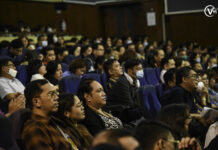
EVERYDAY, housewife Lorna Galang of Silang, Cavite braves the heat just to get her supply of cheap but poor-quality rice from the state-run National Food Authority (NFA).
“Kahit mainit ang panahon at sobrang mahaba ang pila, okay lang basta makakain pa rin kami ng kanin (Although the weather is hot and the line is very long, it is okay for as long as we can still eat rice),” she said.
Galang is one of millions of ordinary consumers who have come to rely more on rice subsidized by the government because commercial rice prices have gone up to more than P40 per kilo. With consumer prices rising and incomes slow to adjust, the poor have no choice but to settle for NFA rice, which costs only P18.25 per kilo.
About seven million Filipino families now rate themselves “mahirap” or poor in terms of food, according to the latest Social Weather Stations survey, with half of Mindanao families and more than third of Metro Manila families considering themselves poor because food has become more expensive.
The crisis brought about by rising prices of commercial rice is a phenomenon resulting from years of pursuing the wrong agricultural policy and failure to invest in propping up farm production. And where public funds were disbursed, several instances of corruption have been exposed, short-changing Filipino farmers and making life difficult for the ordinary consumer.
Globally, high rice prices have been blamed on calamities in place like India and export restrictions in suppliers such as Thailand.
The emerging consensus is that for the long term, the government should work to boost rice production, and pursue policies that will increase incomes and reduce poverty, rather than attacking the problem from the demand or population side as what some have proposed.
Poor productivity
Data from the Philippine Rice Research Institute (PhilRice) show that the Philippines could only harvest an average of three tons of rice per hectare annually, way below the potential 12 tons per hectare of the country’s rich farm lands.
The country, which ironically hosts the International Rice Research Institute, can only produce 90 percent of its rice requirement. Because of this, the Philippines needs to import 2.2 million metric tons of rice this year from suppliers like Vietnam.
“Since we have an existing dependency on imported rice, we should act on something that we can control, something that is within our reach, and that is utilizing a more efficient rice production,” Thomasian economist Alvin Ang said.
Considering unstable prices of grains in the world market, relying on imported rice won’t be a sustainable strategy, said Edwin Martin, professor and public affairs chief of the Philippines Institute for Development Studies.
Thai Grade B rice, one of the rice varieties that the Philippines commonly imports, used to be at $342 per ton but now costs to $1,100 and is expected to become even more expensive.
“More than importation, self-sufficiency is still a safer move to stabilize our supply,” Martin said.
Ang said the government should implement proper land management, considering the rampant conversion of farmlands to other uses, and an effective irrigation system.
Government statistics showed that out of the 4.66 million hectares of land feasible for irrigation, only 1.34 million have water supply, which could not cover even half of the designated land area for farming. Furthermore, only half of the irrigated lands are being served properly and it would take years to develop an efficient irrigation system.
Problems in the farm sector have made rice farming unprofitable. In the case of some farmers, one hectare of arable land would need approximately P5,000 for fertilizers, P2,000 for palay seedlings, another P5,000 to rent a truck to transport the harvest, and a whopping P10,000 for rice milling.
“Para sa amin na hindi naman pag-aari ang lupa, kailangan namin silang bigyan ng 15 hanggang 25 kaban ng bigas (As for us who do not own the land, we need to pay our landlords 15 to 25 sacks of rice),” said farmer Alex Arias one sunny afternoon, at a protest in front of the Department of Agrarian Reform.
In sum, a small farmer needs to shell out around P25,000 every harvest season which yields only 70 to 80 sacks of rice.
Less productive seedlings are keeping rice harvests lean, according to a recent privilege speech by Sen. Edgardo Angara.
Majority of farmlands in the country use ordinary seedlings, which produces only 2.7 tons of rice per hectare compared to the 3.7 tons per hectare yield of certified seedlings. Only 14,300 hectares a year is used for certified seeds, while 60,000 hectares are covered by ordinary and hybrid seeds.
Ang said: “The lands in the Philippines differ (in terms of quality), so research in rice seed varieties should be included in the government’s action to enforce a more effective rice production.”
According to PhilRice, certified seeds would be more beneficial for farmers not only because of a higher yield, but because of savings of up to P3,600 per hectare.
Forty kilograms (kg) of certified seeds would only cost P1,200 and produce at least 800,000 grains of palay (unhusked rice). About 120 kg to 160 kg of ordinary seeds will produce the same amount of palay, but at the cost of P4,800.
May’s Asian Development Bank (ADB) report titled “Food Prices and Inflation in Developing Asia: Is Poverty Reduction Coming to an End?” listed five reasons for weak rice production among Asian countries: poor crop management skills of farmers, use of cheaper seeds, lack of agricultural infrastructure and post-harvest technologies, limited research, and inadequate funding for research and development.
To overcome the effects of these deficiencies, governments of rice dependent countries should exert efforts in improving its “5 I’s”: infrastructure, input availability, institutions, information, and incentives, the Manila-based multilateral institution said.
Martin pointed out that one of the reasons for high rice prices is the fact that Filipino farmers do not directly sell their products to the markets but rather to middlemen, or rice traders.
“Most rice traders’ strategy is that they would buy rice from farmers for a low price and sell it to the public at a much higher price. In a way, they have the power to control the outflow of their rice stocks, which means that they can refuse to sell,” Martin said.
Selling to the NFA is even more unprofitable for farmers, since the government buys rice at even lower prices.
The ADB report stressed that farmers need access to seeds, fertilizers, pesticides, and fuel, but investment in agricultural research is also crucial.
The report noted that in most Asian countries “the most affected by the decline of public sector spending were agricultural research and development and agricultural extension services.” In the Philippines, spending on agricultural research plummeted from 0.7 percent of the farm sector’s output to 0.2 percent from 2000 to 2005.
Funding
The solution to the rice problem is not a novel one. In fact lawmakers passed a law in 1997 to boost the farm sector — the landmark Agriculture and Fisheries Modernization Act (AFMA).
But AFMA has been paralyzed by lack of funding. AFMA should receive an initial funding of P20 billion during its first year of implementation, and not less than P17 billion for the succeeding years. AFMA only received an average of P11.5 billion annually from 2001 to 2007.
The agriculture sector budget is also a picture of priorities gone awry. This year, the government has allotted an all-time low of 2.99 percent of the national budget for the agriculture and agrarian reform departments, way below the 6.09 percent allotment in 2003.
While the government has been scrimping on farm modernization, it has been generous on subsidizing the rice importation activities of the NFA, a government corporation that has been bleeding over the years.
With rice prices going through the roof at the world market, the NFA is expected to lose P35.6 billion this year in its bid to keep the price of subsidized rice at P18.25 per kilo.
The ADB report said giving farmers access to funding, not subsidies, would be a better long-term strategy.
Where’s the money?
The government, though, has been generous on fertilizers and other inputs. But this is an area where massive corruption has reared an ugly head.
In Regions III, V, VII, XI, XIII and the Cordilleras, almost P75 million may have been wasted for administrative costs and the procurement of equipments such as shredders and chippers, instead of funding projects to “(increase) diversified income-generating opportunities for the poor,” the Commission on Audit’s 2006 Value for Money Audit stated.
Four years ago, the P728-million fertilizer scam was discovered by the Senate Committees on Agriculture and Food, and Accountability of Public Officers and Investigations (Blue Ribbon Committee). At the center was former agriculture undersecretary Jocelyn “Joc-Joc” Bolante, who allegedly diverted funds to finance the 2004 election bid of President Gloria Macapagal-Arroyo.
The investigation showed that the fund was just part of the total P2.806 billion Agriculture Department budget, allotted mainly for “farm inputs” which cover fertilizers, seeds, and insecticides. Instead of distributing the fund to Regions IV, V, and VII, Bolante allegedly distributed 30 percent of the budget to mayors, governors, and congressmen and even took 25 percent for himself.
When the Department of Budget and Management released the amount, the fund was charged to AFMA, but the former undersecretary declared that it was intended for another program, the “Farm Inputs and Farm Implements Program.”
The funding was even more questionable as state auditors reported that foliar, a kind of fertilizer appropriate for ornamental plants, but not for rice, was bought at an overprice of 700 to 1,250 percent. Shredders were overpriced by 200 to 300 percent.
Left out?
In the meantime, the Philippines continues to lag behind its Southeast Asian neighbors in terms of strengthening its agricultural capabilities.
In a 2007 study by the World Bank titled “Philippines: Agriculture Public Expenditure Review,” it was revealed that the country’s investment in agriculture declined from 7.3 percent of the sector’s output in 1993 to 6 percent in 1998. It fell to 3.7 percent from the years 2000 to 2004, below Thailand’s 7.3 percent, one of the highest among Southeast Asian countries.
Data from the University of Asia and the Pacific showed that rice production in Thailand and Vietnam has grown by 3 percent and 5.4 percent, respectively for the past ten years, while the Philippines managed to grow by a mere 1.9 percent.
As of April, the country has produced only 10.4 million metric tons of rice, far less than that of Thailand and Vietnam, which produced 18.5 and 23.26 million metric tons, respectively. Statistics also underscored the country’s present billing as the top rice importer in the world, buying 1.9 million metric tons of the staple as of April.
In order to meet rice production demands, President Gloria Macapagal-Arroyo issued Executive Order 723 last May 12 for the release of P12.57 billion to purchase fertilizer and other pieces of farm equipment.
The order is a big boost to the Department of Agriculture’s Rice Self-Sufficiency Plan, which aims to reduce dependence on imports by producing 98 percent of the country’s rice requirement by the year 2010. The department is focusing on increasing rice production to 17.3 million tons this year and to 18 million tons and 19.3 million tons by 2009 and 2010, respectively.
Wrong tree
In his study titled “The Rice Situation: Is there a shortage?” University of Asia and the Pacific professor Rolando Dy said population growth had nothing to do with the so-called rice crisis.
Rather, it is the low purchasing power of the Filipinos, and the government’s poor track record in reducing poverty that causes the crisis. Because of this, Dy said Filipinos find it hard to buy basic commodities such as bread, meat, and vegetables.
The ADB has advised governments that the best short-term measures are temporary subsidies targeted to the poorest people, and an emergency food reserve system. In any case, it cannot be business as usual.
“A reevaluation of investment priorities and feasibility of agricultural projects must be undertaken in light of these price developments, accompanied by stronger efforts to boost agricultural productivity growth in order to mitigate any longer term rise in food prices,” the ADB said.



















